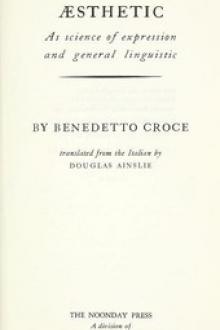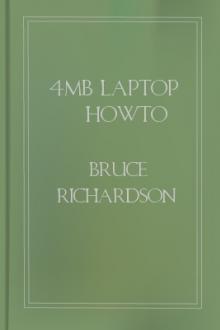Aesthetic as Science of Expression and General Linguistic, Benedetto Croce [read e books online free TXT] 📗

- Author: Benedetto Croce
- Performer: 1426434839
Book online «Aesthetic as Science of Expression and General Linguistic, Benedetto Croce [read e books online free TXT] 📗». Author Benedetto Croce
Would not an artist vary and touch up much or little, remove or add something to any of them?
[Sidenote] Critique of art conceived as a sentimental not a theoretical fact. Aesthetic appearance and feeling.
The statements repeated so often, with others similar, that art is not knowledge, that it does not tell the truth, that it does not belong to the world of theory, but to the world of feeling, arise from the failure to realize exactly the theoretic character of the simple intuition. This simple intuition is quite distinct from intellectual knowledge, as it is distinct from the perception of the real. The belief that only the intellective is knowledge, or at the most also the perception of the real, also arises from the failure to grasp the theoretic character of the simple intuition. We have seen that intuition is knowledge, free of concepts and more simple than the so-called perception of the real.
Since art is knowledge and form, it does not belong to the world of feeling and of psychic material. The reason why so many aestheticians have so often insisted that art is appearance (_Schein_), is precisely because they have felt the necessity of distinguishing it from the more complex fact of perception by maintaining its pure intuitivity. For the same reason it has been claimed that art is sentiment. In fact, if the concept as content of art, and historical reality as such, be excluded, there remains no other content than reality apprehended in all its ingenuousness and immediateness in the vital effort, in sentiment, that is to say, pure intuition.
[Sidenote] Critique of theory of aesthetic senses.
The theory of the aesthetic senses has also arisen from the failure to establish, or from having lost to view the character of the expression as distinct from the impression, of the form as distinct from the matter.
As has just been pointed out, this reduces itself to the error of wishing to seek a passage from the quality of the content to that of the form. To ask, in fact, what the aesthetic senses may be, implies asking what sensible impressions may be able to enter into aesthetic expressions, and what must of necessity do so. To this we must at once reply, that all impressions can enter into aesthetic expressions or formations, but that none are bound to do so. Dante raised to the dignity of form not only the “sweet colour of the oriental sapphire”
(visual impression), but also tactile or thermic impressions, such as the “thick air” and the “fresh rivulets” which “parch all the more” the throat of the thirsty. The belief that a picture yields only visual impressions is a curious illusion. The bloom of a cheek, the warmth of a youthful body, the sweetness and freshness of a fruit, the cutting of a sharpened blade, are not these, also, impressions that we have from a picture? Maybe they are visual? What would a picture be for a hypothetical man, deprived of all or many of his senses, who should in an instant acquire the sole organ of sight? The picture we are standing opposite and believe we see only with our eyes, would appear to his eyes as little more than the paint-smeared palette of a painter.
Some who hold firmly to the aesthetic character of given groups of impressions (for example, the visual, the auditive), and exclude others, admit, however, that if visual and auditive impressions enter directly
into the aesthetic fact, those of the other senses also enter into it, but only as associated. But this distinction is altogether arbitrary.
Aesthetic expression is a synthesis, in which it is impossible to distinguish direct and indirect. All impressions are by it placed on a level, in so far as they are aestheticised. He who takes into himself the image of a picture or of a poem does not experience, as it were, a series of impressions as to this image, some of which have a prerogative or precedence over others. And nothing is known of what happens prior to having received it, for the distinctions made after reflexion have nothing to do with art.
The theory of the aesthetic senses has also been presented in another way; that is to say, as the attempt to establish what physiological organs are necessary for the aesthetic fact. The physiological organ or apparatus is nothing but a complex of cellules, thus and thus constituted, thus and thus disposed; that is to say, it is merely physical and natural fact or concept. But expression does not recognize physiological facts. Expression has its point of departure in the impressions, and the physiological path by which these have found their way to the mind is to it altogether indifferent. One way or another amounts to the same thing: it suffices that they are impressions.
It is true that the want of given organs, that is, of given complexes of cells, produces an absence of given impressions (when these are not obtained by another path by a kind of organic compensation). The man born blind cannot express or have the intuition of light. But the impressions are not conditioned solely by the organ, but also by the stimuli which operate upon the organ. Thus, he who has never had the impression of the sea will never be able to express it, in the same way as he who has never had the impression of the great world or of the political conflict will never express the one or the other. This, however, does not establish a dependence of the expressive function on the stimulus or on the organ. It is the repetition of what we know already: expression presupposes impression. Therefore, given expressions imply given impressions. Besides, every impression excludes other impressions during the moment in which it dominates; and so does every expression.
[Sidenote] Unity and indivisibility of the work of art.
Another corollary of the conception of expression as activity is the indivisibility of the work of art. Every expression is a unique expression. Activity is a fusion of the impressions in an organic whole.
A desire to express this has always prompted the affirmation that the world of art should have unity, or, what amounts to the same thing, unity in variety. Expression is a synthesis of the various, the multiple, in the one.
The fact that we divide a work of art into parts, as a poem into scenes, episodes, similes, sentences, or a picture into single figures and objects, background, foreground, etc., may seem to be an objection to this affirmation. But such division annihilates the work, as dividing the organism into heart, brain, nerves, muscles and so on, turns the living being into a corpse. It is true that there exist organisms in which the division gives place to more living things, but in such a case, and if we transfer the analogy to the aesthetic fact, we must conclude for a multiplicity of germs of life, that is to say, for a speedy re-elaboration of the single parts into new single expressions.
It will be observed that expression is sometimes based on other expressions. There are simple and there are compound expressions. One must admit some difference between the eureka, with which Archimedes expressed all his joy after his discovery, and the expressive act (indeed all the five acts) of a regular tragedy. Not in the least: expression is always directly based on impressions. He who conceives a tragedy puts into a crucible a great quantity, so to say, of impressions: the expressions themselves, conceived on other occasions, are fused together with the new in a single mass, in the same way as we can cast into a smelting furnace formless pieces of bronze and most precious statuettes. Those most precious statuettes must be melted in the same way as the formless bits of bronze, before there can be a new statue. The old expressions must descend again to the level of impressions, in order to be synthetized in a new single expression.
[Sidenote] Art as the deliverer.
By elaborating his impressions, man frees himself from them. By objectifying them, he removes them from him and makes himself their superior. The liberating and purifying function of art is another aspect and another formula of its character of activity. Activity is the deliverer, just because it drives away passivity.
This also explains why it is customary to attribute to artists alike the maximum of sensibility or passion, and the maximum insensibility or Olympic serenity. Both qualifications agree, for they do not refer to the same object. The sensibility or passion relates to the rich material which the artist absorbs into his psychic organism; the insensibility or serenity to the form with which he subjugates and dominates the tumult of the feelings and of the passions.
III ART AND PHILOSOPHY[Sidenote] Indissolubility of intellective from intuitive knowledge.
The two forms of knowledge, aesthetic and intellectual or conceptual, are indeed diverse, but this does not amount altogether to separation and disjunction, as we find with two forces going each its own way. If we have shown that the aesthetic form is altogether independent of the intellectual and suffices to itself without external support, we have not said that the intellectual can stand without the aesthetic. This reciprocity would not be true.
What is knowledge by concepts? It is knowledge of relations of things, and those things are intuitions. Concepts are not possible without intuitions, just as intuition is itself impossible without the material of impressions. Intuitions are: this river, this lake, this brook, this rain, this glass of water; the concept is: water, not this or that appearance and particular example of water, but water in general, in whatever time or place it be realized; the material of infinite intuitions, but of one single and constant concept.
However, the concept, the universal, if it be no longer intuition in one respect, is in another respect intuition, and cannot fail of being intuition. For the man who thinks has impressions and emotions, in so far as he thinks. His impression and emotion will not be love or hate, but the effort of his thought itself, with the pain and the joy, the love and the hate joined to it. This effort cannot but become intuitive in form, in becoming objective to the mind. To speak, is not to think logically; but to think logically is, at the same time, to speak.
[Sidenote]





Comments (0)